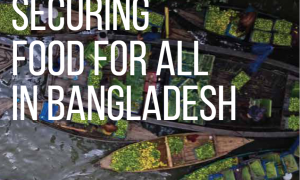Data from 3 irrigation schemes in Mozambique reveal patterns consistent with water inefficiency. A feedback tool could visually communicate ways to conserve by varying water applications at each stage of the crop cycle.
Search
Migration and gender dynamics of irrigation governance in Nepal
Nepal has a long history of irrigation, including government and farmer-managed irrigation systems that are labor- and skill-intensive. Widespread male migration has important effects on Nepalese society.
Food is the most important basic need for sustenance and survival, and the right to food is among the fundamental human rights.
Securing Food for All in Bangladesh presents an array of research that collectively addresses four broad issues: (1) agricultural technology adoption; (2) input use and agricultural productivity; (3) food security and output markets; and (4) pover
Technology is the basis for sustainable agricultural growth. Enhanced agricultural productivity and growth depend, to a large extent, upon the widespread adoption of appropriate technologies by farmers.
In Bangladesh, the dry season of October to March is characterised by falling water tables, reduction in the discharge of major rivers, drying water channels, and salinity intrusion, particularly in the southwest coastal region.
Despite declining arable agricultural land, Bangladesh has made substantial progress in boosting domestic food production, improving access to food by increasing household income, and enhancing nutritional outcomes
Agricultural production in Bangladesh has undergone dramatic changes over the past several decades.
Crop production and farm incomes in two areas of the central dry zone: Findings from June 2021
Using data from six phone survey rounds between June 2020 and June 2021, we found that the impacts of the recent political unrest in Myanmar further compound the disruptions caused by the COVID-19 pandemic, both on the farm as well as on the non-f
The importance of women’s roles for nutrition-sensitive agricultural projects is increasingly recognized, yet little is known about whether such projects improve women’s empowerment and gender equality.
Low and variable yields of wheat in the rice--wheat cropping systems of lower Indo-Gangetic Plains (IGP) of South Asia, covering Bihar and Eastern Uttar Pradesh (EUP) in India and the Terai region of Nepal, are a matter of significant concern for
Proposed Balochistan agriculture policy 2021
Balochistan is the largest province of Pakistan comprising 44% of the country’s total land mass with a population of 12.34 million (5.9 percent of total population of the country), its southern border of Balochistan makes up two-thirds (770 KM) of
Assessing the economic cost of depleting groundwater in Balochistan: A Social Accounting Matrix (SAM) multiplier approach
Prolonged droughts and depleting groundwater resources have been a serious challenge to the economy of province of Balochistan, Pakistan.
We study production practices of larger and more capital-intensive farmers (“horti-preneurs”) in horticultural commercial clusters in the central Rift Valley of Ethiopia.
A cultivated planet in 2010 - Part 2: The global gridded agricultural-production maps
Data on global agricultural production are usually available as statistics at administrative units, which does not give any diversity and spatial patterns; thus they are less informative for subsequent spatially explicit agricultural and environme
The persistent and worsening effects of the COVID-19 crisis on rural household incomes are alarming. The onset of the second wave of infections and mitigation measures in Myanmar is continuing to depress household incomes.

